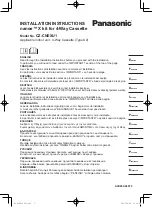
GB - 2
General information
Correct use
Unit installation
Read this instruction manual thoroughly
before installing the unit and keep it for
further consultation even after installation.
• This unit complies with the following
directives:
- low-voltage 73/23/CEE;
- electromagnetic compatibility
89/336/CEE;
- PED Pressure Equipment
97/23/CE;
- energy labelling
2002/31/CE.
• For safety reasons, installers are required to
read the general information carefully.
• Follow all the instructions below to ensure
safety.
• Inspect the unit for damage due to improper
transport. In case of damage, file an
immediate claim with the shipping company.
• Do not install or use damaged equipment.
• To prevent fire, explosion or injury, do not
operate the unit near dangerous substances
or close to naked light equipment.
• Ensure that national safety code
requirements have been followed for the
main supply circuit. Follow all current
national safety code requirements for the
installation.
• Make sure a connected ground wire is in
place.
• Check that voltage and frequency of the
mains power supply are those required for
the unit to be installed; the available power
must be adequate to operate any other
appliances connected to the same line.
• The manufacturer declines any liability from
damage resulting from modifications in the
unit or errors in the electrical or hydraulic
connections.
Failure to observe the installation
instructions, or use of the unit under
conditions other than those indicated in the
table “Operating limits” of the unit owner’s
manual, will immediately invalidate the unit
warranty.
• It is recommended to install a circuit breaker
or a 10 A safety fuse upstream of the supply
outlet.
Unit operation
• In order to avoid electric shock, fire or injury,
stop the unit in case of abnormal events
(such as smell of burning) and call Carrier
Service for further instructions.
• Do not place containers filled with liquids or
other objects onto the unit.
Maintenance
• A routine maintenance should be carried out
on the unit to check the correct operation of
the electric connections and protection
devices.
• Maintenance operations must be carried out
by specially trained personnel.
• Do not attempt to repair, move, modify the
unit on your own.
To avoid electric shock or fire make sure
these operations are carried out by qualified
personnel only.
• Contact the qualified service if one of the
following events takes place:
- hot or damaged power supply cable;
- unusual noise during operation;
- frequent operation of the protection
devices;
- unusual smell (such as smell of burning).
Choosing the installation site
• Choose an area free from obstructions
which may cause irregular air distribution
and/or return.
• Choose a position that allows for the
clearances required (see “Correct use”
section).
• Look for a position in the room which
assures the best possible air distribution.
Positions to avoid:
• Exposed to direct sun.
• Too close to heat sources.
• On humid walls or positions with water
hazard, e.g. laundry premises.
• Exposure to oil vapours (e.g. kitchens,
workshops).
• Where curtains or furniture may obstruct free
air circulation.
Unit disposal:
• At the end of its life, the air conditioner must
be delivered to a special collection centre or
to the dealer for the refrigerant disposal.
• All of the manufacturing and packaging
materials used for this unit are compatible
with the environment and can be recycled.
• Dispose of the packaging material in
accordance with local requirements.
Unit performance:
The unit is designed to operate within the
following temperature limits according to the
standards:
Cooling: (EN14511:2004)
Max. 35
°
C d.b.* / 24
°
C w.b.*
Min. 21
°
C d.b.* / 15
°
C w.b.*
* d.b. - dry bulb temperature -
* w.b. - wet bulb temperature
IMPORTANT
At first start-up of the unit proceed as
follows:
• take out the water tank at the rear of the air
conditioner
• remove the adhesive tape strip
• replace the tank correctly in its position
If the above procedure is not followed, the unit
will not operate and indicate a fault.
The unit is equipped with
rollers to facilitate relocation.
It is recommended to move
the unit holding the front
panel as illustrated.
Always disconnect the cable from the power socket before
moving or cleaning the unit.
Never use the plug to switch the unit on or off.

























